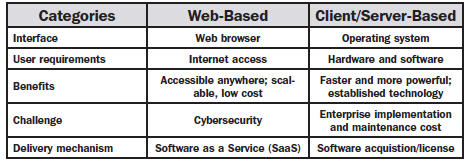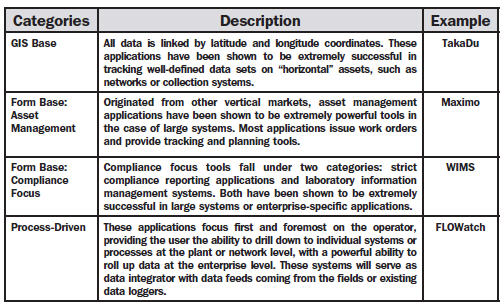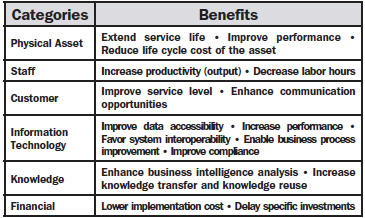Keeping Pace With Data Management Evolution
By Dr. Bruno Levine, president and cofounder, FLOWatch
How to harness technology and information to overcome modern municipal challenges
According to the Water Research Foundation, the volume of data generated by water/wastewater utilities is doubling every three years with increasing automation and adoption of new systems and applications. Simultaneously, operators are retiring at an unprecedented rate, leading to a tremendous loss in knowledge and experience. The recent economic downturn created a third stress point, asking utilities to do more with less, in spite of infrastructure challenges. Fortunately, the Internet, tablet-based computing, and various wireless technologies are providing operators and utilities with a new set of tools to tackle the challenges at hand.
The purpose of this paper is to provide the reader with a cursory overview of the data management evolution taking place today, recognizing that we are in the early stages of this transformation and that many professionals are still in discovery mode.
Recent Technical Evolution
Leveraging The Cloud — Until recently, the two biggest hurdles small and midsize utilities faced when it came to IT projects were hardware and software costs. With the introduction of cloud-based solutions, the point of entry to undertake IT projects has dropped significantly, leading to more cost-effective alternatives.
In the case of cloud-based solutions, the utility has the option to hire a third party to manage its software and hardware risks through a hosted solution. In doing so, the data generated by the utility can securely reside off-site. The immediate benefit for small-to-midsize utilities is a lower-cost solution, because hosting vendors are able to spread their costs over a larger number of customers, providing significant economies of scale. Be aware, however, that not all cloud solutions are identical, and the market offers public, private, and hybrid clouds with varying feature-sets and associated capital and maintenance costs. Utilities will need to carefully evaluate their internal corporate, compliance, and security policies before adopting a specific path.
Additionally, for a utility, not all systems should be made available over the Internet. For security reasons, utilities are advised to keep operational control systems such as SCADA (supervisory control and data acquisition) off the Web, using desktop-oriented client/server technology. The recommended practice is to dissociate enterprise data management systems from operational and plant-critical platforms. Under this configuration, data is pushed with no direct link among systems. In other words, SCADA systems should be managed separately from enterprise data management platforms, the first providing real-time operational control and the second near-real-time operational oversight focusing on business and operational intelligence.
The following table outlines a high-level comparison between Web-based and client/server systems. In the coming years, utilities will continue to leverage both technologies.

Building An Integrated Data Management Vision — Other key innovations taking place are shaping the future of the industry. The vision proposed by Biju George, Greater Cincinnati Water Works general manager, is a fully integrated solution bringing together wireless technologies, field data collection improvements, and mathematical and predictive engineering models. A set of targeted services for the utility manager to help operate the plant in an optimal mode is built around this. Hardware and software innovations are, once again, among the key building blocks to this vision.
Wireless Technologies: While meter companies have undergone tremendous changes in the last few years by combining drive-by and fixed network solutions, the most groundbreaking innovation is yet to come. Companies such as Qualcomm are starting to integrate smartphone technology into meters, enabling utilities to leverage existing cellular networks as a means of pushing data. Soon, 3G smart meter technologies will be integrated in pH meters, turbidity meters, and most online analyzers.
The immediate benefit of such technologies will be a lower installation and integration cost, since these systems will be in a position to push data without having to be hardwired to a data logger. This can be further improved if system and data compatibility across carriers and vendors is established.
Data Standards And Exchange Guidelines: The water industry is moving toward the concept of industry-wide data standards and exchange protocol guidelines. This effort removes fragmentation within the market where vendors have developed internal data schemas and middleware services and removes hurdles for safe and secure data exchange. Vendors, such as engineering companies, can then focus on their core product offerings, many of which include predictive modeling and design-related functionality.
In 2012, the Water Research Foundation funded a meter data management project. State regulatory agencies have begun transitioning toward reporting practices that incorporate data standards such as NetDMR (network discharge monitoring report), the EPA’s electronic reporting tool. The challenge for the industry will be to consolidate all these initiatives under one group and assure consistency. This concept is not new. Other vertical markets, such as the power and banking industries, have undergone such initiatives. In all cases, individual companies and the industry at large benefited from direct savings due to faster and cheaper data integration projects.
Applications Architecture: Until recently, enterprise-class operational applications were developed as client/ server applications and fell under one of two categories: GIS (geographical information system)-based systems or forms-based applications. Under this second category are two additional subcategories: compliance- and asset management-based applications. While all three categories are well-suited for their original intent, they are not sufficiently intuitive from a process-based perspective.

A new class of applications is now entering the market. This new class is based on newer technologies such as HTML5 and CSS3, but still incorporates solid process engineering principles, providing the user with greater flexibility to address all business-critical operational reporting needs. For small and midsize utilities, this new design presents two benefits: affordability and configurability. With this new class of software, small-to-midsize utilities will be able to access all key functions under one interface, while preserving any investments they have already made. The table above compares these four categories of applications.
Future Impact
As a result of the ongoing technical evolution, utilities and operators will need to adjust to this new paradigm, leading to organizational and functional changes impacting core business practices. If managed correctly, there are potential benefits for the utility in operational costs savings, as well as establishing a consistent and reliable reporting framework.
Change Is Coming — In order to achieve these savings, utilities will need to adjust their existing processes, procedures, and policies. However, care should be taken so that changes will not impact the primary purpose of any water/wastewater utility, which is to protect the health and wellbeing of both the environment and the public. Additionally, the changes should not negatively impact the operators’ capacity to act correctly and swiftly in times of crisis. Taking into account these basic principles, here are some examples of changes and adjustments utilities will need to make moving forward.
Staffing Changes: New positions will be created, and new skills will be required to integrate these technologies. Here are two examples:
- Business Analysis: The role of a business analyst (BA) will be to assess the operational efficiency of a plant or system based on near-real-time assessment of the data. A BA will work in tandem with operators to see how operating conditions can be enhanced but also work with other key players within the organization such as reporting, finance, and executive leadership to incorporate their needs into a single, consistent vision.
- Operational IT: IT managers today are responsible for managing servers and providing direct hardware/software support across the enterprise. Moving forward, specialized Operational IT positions will be created to support operators in their specific IT and reporting needs. These positions have to be filled by candidates who are grounded in engineering but have an interest in technology and the capability to mix the two with meaningful impact. This service could also be fulfilled by third-party contractors.
While meter companies have undergone tremendous changes in the last few years by combining drive-by and fixed network solutions, the most groundbreaking innovation is yet to come.
Organizational Changes: In addition to bringing on board new skills, the organization will need to develop new procedures around the use of data.
- Data Quality: As information footprint increases, utilities will have to develop data-related procedures and policies to ensure data quality. Emphasis will be on structure, storage, and organization of various streams of data, integrity checks during any data transformation, and auditing capability. This can be a new opportunity for engineering and consulting firms to assist the utility manager and can lead to other products and services to improve and sustain operational performance.
- Key Performance Indicators (KPIs): With operational data becoming readily available, organizations will be able to analyze, create, and keep track in near-real-time KPIs that were previously not available. The KPIs can be operational but also compliance- or managementrelated, such as a water-quality violation or cross-plant variability where the utility owns and operates several treatment plants.
- Partnership and Collaboration: As a result of data becoming more ubiquitous across the enterprise, utilities will have the opportunity to revisit their communication and outreach strategy with upstream or downstream utilities, as well as environmental and public advocacy groups. As a result, new business and partnering opportunities will surface where organizations can act in tandem and make decisions that benefit not just one community, but groups of communities.
Benefits: Due to the lack of historical data, most studies identifying the long-term benefits to utilities and operators following the implementation of such solutions are strictly speculative. However, based on past implementations of early-stage technologies, the general consensus identifies savings of up to 30 percent across all operating expenses. According to Swan Analytical, a U.K.-based smart water network group, the overall potential savings could exceed $70 billion worldwide. The following table identifies some of the areas where utilities can see substantial benefit.

Service-Oriented Approach: In this evolution, there will be a new market for consultants and engineering companies that specialize in technology-related services. Until now, many utilities have housed IT departments in-house and have made procurements in software and hardware. With the maturing of cloud-based solutions, the utility will be an attractive alternative to outsource significant IT operations. SaaS and Infrastructure as a Service (IaaS) are two areas where utilities can decrease their footprint in software and hardware, respectively. This also reduces the capital expenditure for the utility and will be considered an operational expense.
While these distinctions are important, the process by which utilities should evaluate the service offering has not changed. A few key concepts to keep in mind are:
- Is the application configurable by the user?
- Are customizations required as part of the implementation?
- Are there significant costs to onboarding and offboarding?
- Is a phased rollout possible?
- How do applications interact with other vendor systems?
- Are systems available 24/7 (99.9 percent availability is considered a good benchmark)?
- Are there disaster-recovery options in place?
Conclusion
The operational data management evolution is bringing to operators and utility managers new means of tracking monitoring and managing their systems in near-real time. In the coming years, utilities will be increasingly leveraging these tools, driving change across the industry.
The three key factors driving this change are (1) the use of the cloud to store data, (2) the use of mobile devices to push and access this data, and (3) the adoption of easy-to-use and easy-to-implement operational data management platforms. Of these three categories, the latter is the most difficult to choose.
In selecting a platform, the utility is in reality selecting a partner. In other words:
- Spend time with the technology and implementation team.
- Understand the genesis of the technology and the company’s vision.
- Ask for a pilot as part of your valuation process.
- Don’t be dazzled by fancy and slick presentations.
 Dr. Bruno Levine (bruno.levine@flowatch.com) has more than 20 years of water, wastewater, and water reuse experience in research, operational engineering, and business development, working for utilities in the U.S. and Europe. Levine is currently president and cofounder of FLOWatch. He holds a doctorate in environmental science and engineering from UCLA and an MBA from Columbia Business School.
Dr. Bruno Levine (bruno.levine@flowatch.com) has more than 20 years of water, wastewater, and water reuse experience in research, operational engineering, and business development, working for utilities in the U.S. and Europe. Levine is currently president and cofounder of FLOWatch. He holds a doctorate in environmental science and engineering from UCLA and an MBA from Columbia Business School.
